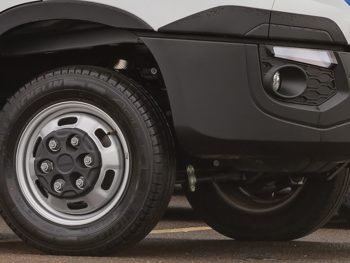Prepping cars and vans laid-up for extended periods could ensure they’re ready to re-enter operations when normal service resumes.

Michelin has warned that tyres can be damaged if certain precautions are not taken before the weight of a parked car or light commercial is supported for long periods – meaning they could need replacement tyres – but basic advice could avoid this.
Preparing vehicles
Before laying up a car or van, the tyres should be checked for damage and any cuts or penetrations that may deteriorate over time should be assessed by an expert. Many tyre dealerships remain open, often with mobile technicians available for supporting fleet business.
Inflation pressures should be set at the normal levels for the vehicle. Any tyre which is found to be under-inflated by up to 7psi can normally be re-inflated safely if there are no obvious signs of damage. However, if a tyre is under-inflated by more than 7psi, it should be removed and inspected by an expert to make sure that no structural damage has been caused.
Tyres inflated with nitrogen should have their inflation pressure checked in just the same way as those inflated with air. Whatever the inflation medium, ensure that a valve cap with a rubber seal is fitted to every tyre valve.
Make sure that tyres are not parked on stones or objects that might dig in. Also avoid tyres sitting for long periods in pools of water or other liquids, such as oils. For longer periods, covering tyres to avoid exposure to sunlight will also prolong their life.
Clean tyres with mild detergent only and rinse well with cold water.
During extended parking
Even when not in use, tyre inflation pressures should still be regularly checked and corrected as necessary – ideally on a monthly basis, in line with standard Michelin recommendations. Any pressure loss should be investigated and the cause remedied.
Every four months, if a vehicle has not been moved, the tyres should be rotated a quarter turn.
Re-entry into service
Any tyre and wheel assembly which has been stored for a long period, on or off the vehicle, should be visually inspected for damage and any unusual signs before re-entering service. Pressures should be checked and set to the vehicle manufacturer’s recommendation.
Remember that tyres may reach the end of their service life whilst in storage. Tyres which have been in use for five years or more should continue to be inspected by a specialist at least annually. Any tyres in service 10 years or more from the date of manufacture, including spare tyres, should be replaced with new tyres as a simple precaution – even if they still appear serviceable and have not reached the legal wear limit.
The date when a tyre was manufactured is located on the sidewall. Consumers should locate the code which begins with the letters DOT. A DOT code ending in ‘2210’ indicates a tyre made in the 22nd week (May) of 2010.
Brian Porteous, Michelin’s technical manager – car, van, 4×4 and government contracts, added: “We appreciate that for most businesses, the very idea of parking vehicles for extended periods is an unfamiliar process and not something they want to be doing. However, by spending a few minutes inspecting and preparing a vehicle first, you will help to protect the condition of its tyres and ensure it is in the best possible condition for getting back to work when the time comes.”

